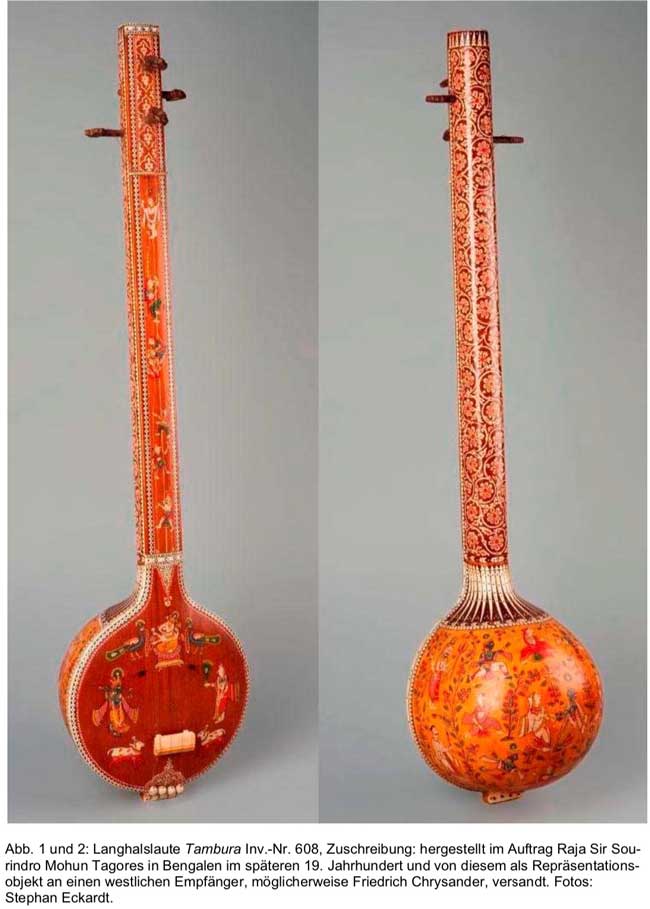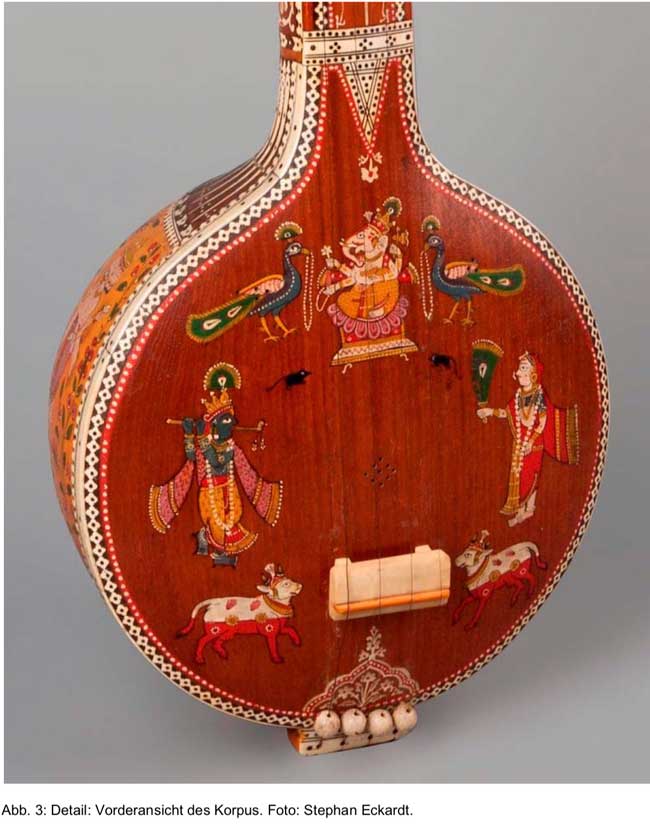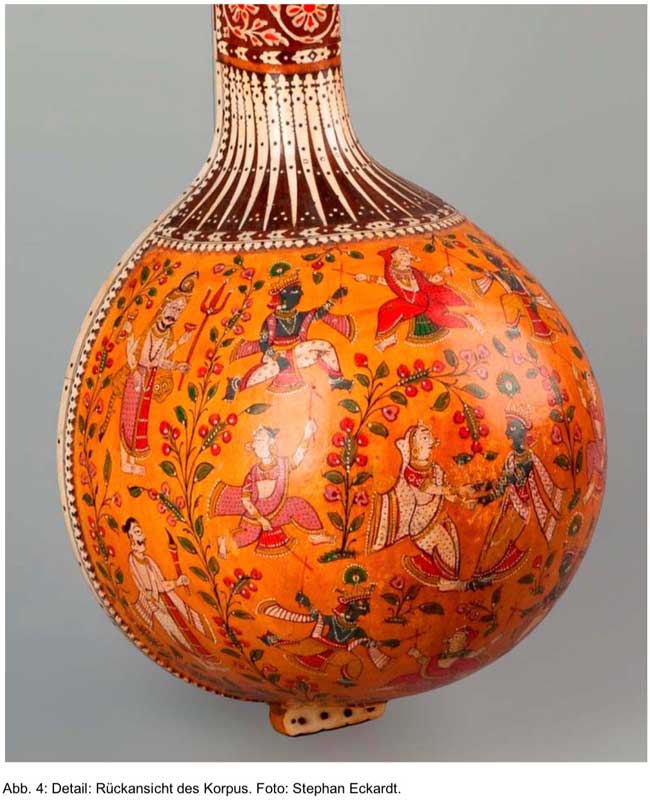As performers-cum-teachers, we should practise with the traditional tambura and teach music with the same to the students.
Malladi Brothers quoted by Aruna Chandaraju in The Hindu >>
Learn more about the tambura (tanpura) >>
Tambura posture, fingering & therapeutic effect
By Rama Kausalya
The Tambura is considered queen among the Sruti vadhyas such as Ektar, Dotar, Tuntina, Ottu and Donai. Although tamburas are traditionally made at several places, the Thanjavur Tambura has a special charm.
Veena Asaris are the Tambura makers too but not all are experts, the reason being it requires a special skill to make the convex ‘Meppalagai’ or the plate covering the ‘Kudam’ (Paanai).
There are two ways of holding a Tambura. One is the “Urdhva” – upright posture, as in concerts. Placing the Tambura on the right thigh is the general practice. The other is to place it on the floor in front of the person who is strumming it. While practising or singing casually, it can be placed horizontally on the lap.
The middle finger and index finger are used to strum the Tambura. Of the four strings, the ‘Panchamam’, which is at the farther end is plucked by the middle finger followed by the successive plucking of ‘Sārani’, ‘Anusārani’ and ‘Mandara’ strings one after the other by the index finger. This exercise is repeated in a loop resulting in the reverberating sruti.
Sit in a quiet place with eyes closed and listen to the sa-pa-sa notes of a perfectly tuned Tambura – the effect is therapeutic.
Except a few, the current generation prefers electronic sruti accompaniment, portability being the obvious reason. Besides few music students are taught to tune and play the tambura. Beyond all this what seems to swing the vote is that the electronic sruti equipment with its heavy tonal quality can cover up when the sruti goes astray.
During the middle of the last century, Miraj Tambura (next only to the vintage Thanjavur) was a rage among music students, who were captivated by its tonal quality with high precision and the beautiful, natural gourd resonators.
Source: “Therapeutic effect”, The Hindu (Friday Review), 30 March 2018
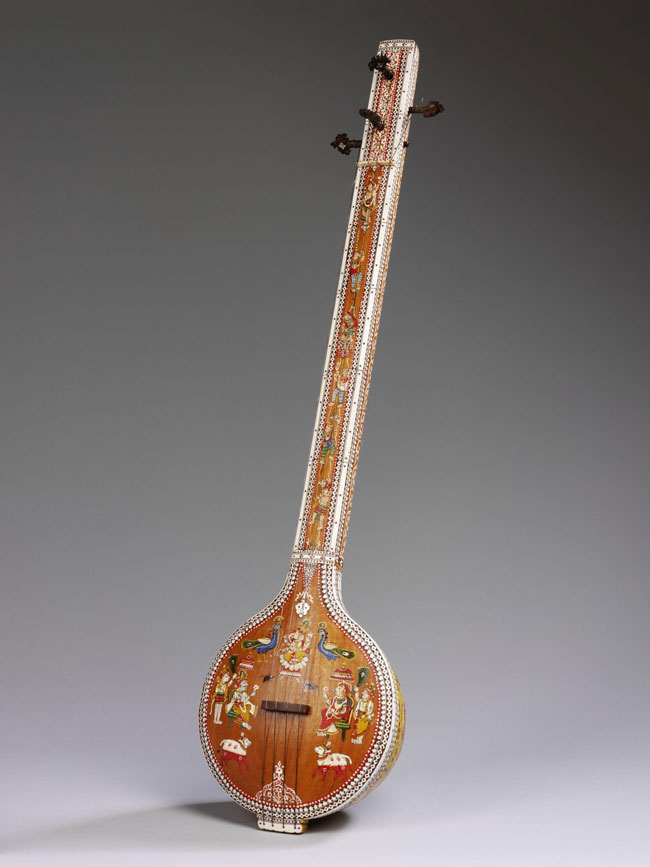
View this and close images in high resolution >>
Source: Musical instrument (tanpura) with keys for four string, © Victoria and Albert Museum, London, 2021
URL: https://collections.vam.ac.uk/item/O452622/stringed-instrument/
Date Visited: 7 December 2021
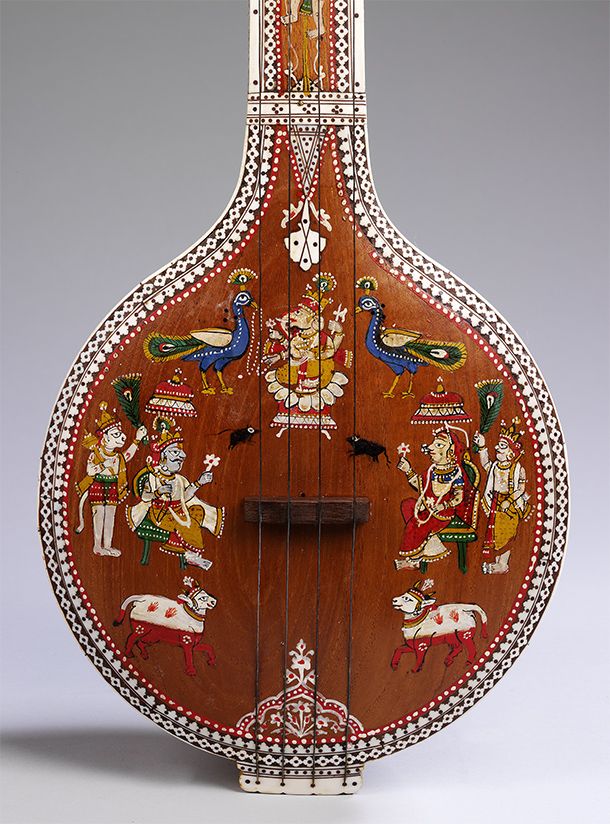
View more details here >>
The tambura or tanpura is a plucked drone instrument used to accompany instrumental or vocal performances. The four strings are played open rather than being depressed to alter the note. This example is considerably smaller than the typical tambura. A very small version is sometimes known as a tamburi.
This example is so profusely decorated it may have been made for display or for use at court. The front of the sound chamber features images of the Hindu deities Ganesha, Rama, Sita, Hanuman and Lakshmana, along with peacocks and cows. The neck is decorated with figures of a male musician playing a pipe or horn, a female musician playing a drum, and acrobats, who appear to be climbing a very tall bamboo pole. One of the female acrobats has a number of matkas (earthenware pots) stacked upon her head.
On the back, Krishna appears five times dancing with the gopis (cow-girls) in a circular pattern. They are flanked by four standing figures: the gods Shiva (holding his trident) and Brahma (shown with four heads and holding the vedas or sacred texts), and two rishis or great sages. The one standing below Brahma is Narada, who holds a vina, a musical instrument which he is said to have invented. He also wrote a treatise about music and was the chief of the gandharvas or heavenly musicians.
This tambura belongs to a small and fascinating group of similar tamburas, of which there are examples in museums around the world. However, most of these lack secure attribution records and the origins of the V&A instrument are something of a puzzle. The Museum’s records from 1922, when the object was acquired, state separately that it was from Pune, Maharashtra, and, slightly later, that it was probably made in Sipri (now Shivpuri), near Gwalior, Madhya Pradesh, although these places are very distant from each other. However, the fact that the sound chamber of the instrument is made of wood [?], rather than of gourd, suggests that it was made in the south of India as do other aspects of the shape of the instrument, and it has been suggested that the painting style can be linked with Mysore in the south. […]
Source: Tambura – On display in South Asia, Room 41, 16 September 2015 – 31 October 2016
URL: http://www.vam.ac.uk/content/exhibitions/display-musical-wonders-of-india/tambura/
Date Visited: 7 December 2021
Decorated instruments are also found in German, Austrian and Italian collections. According to Klaus-Peter Brenner, a similar instrument in the musical instrument collection of Goettingen University may have been manufactured on behalf of Raja Sir Sourindro Mohan Tagore (1840-1914). If this is indeed the case (even if hard to ascertain), the pioneering musicologist may have gifted it to a visiting dignitary (Erzherzog Franz-Ferdinands von Österreich), as he did with numerous other instruments. This particular one is now being described as Göttinger Tagore-Tambura.
Die derzeit bekannten Parallelstücke lassen eine Provenienz entweder aus den Instrumentenschenkungen des bengalischen Musikwissenschaftlers Raja Sir Sourindro Mohan Tagore (1840-1914) an europäische Museen und Privatleute oder vom Indienaufenthalt Erzherzog Franz-Ferdinands von Österreich-Este im Jahre 1893 (briefl. Mitteilung vom 26. 9. 1986 von Dr. Alfred Janata zur Herkunft des Wiener Exemplars) vermuten, was jedoch ebenfalls auf eine Verbindung zu Tagore hindeutet, da Erzherzog Franz-Ferdinand während seiner Reise bei diesem zu Gast war (cf. HÖFER 2010: 51).
More details and high resolution images are found here:
https://sammlungen.uni-goettingen.de/objekt/record_kuniweb_676140/
Photo credit © Stephan Eckardt (Goettingen University)
Additional information in German: Klaus-Peter Brenner in “Die Göttinger Tagore-Tambura und der Beginn des musikwissenschaftlichen Austauschs zwischen Indien und dem Westen im späteren 19. Jahrhundert”, first published in “Die Göttinger Tagore-Tambura und der Beginn des musikwissenschaftlichen Austauschs zwischen Indien und dem Westen im späteren 19. Jahrhundert” (Musik‐ wissenschaftlichen Seminars der Universität Göttingen, 2012)
Read or download the full article (in German) with detailed Bibliography
[Bold typeface added above for emphasis]

Information about the persons, items or topics
Research & Custom search engines
The Oxford Illustrated Companion to South Indian Classical Music
Learn & practice more
A brief introduction to Carnatic music (with music examples and interactive map)
Bhava and Rasa explained by V. Premalatha
Free “flow” exercises on this website
Introduction (values in the light of modernity)
Video | Keeping tala with hand gestures: Adi (8 beats) & Misra chapu (7 beats)
Why Carnatic Music Matters More Than Ever
Worldcat.org book and journal search (including Open Access)
